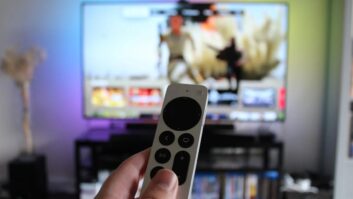
Editor’s Note: This article originally appeared on What Hi-Fi?
In my line of work, I tend to see quite a lot of new TVs – shocking, I know. A benefit of being a major AV geek such as myself is that I get to spend some quality time with the latest TVs before they’re even announced, and more often than not they’re presented enthusiastically by a representative of the manufacturer who’s keen to tell me about all of the latest and greatest features.
These guided demos are often a great way to see everything that the new TVs are capable of ahead of their full release and are often the basis for our hands-on reviews. That being said, I have noticed a recurring feature on a lot of TVs that I just can’t make my mind up about.
Dialogue enhancement; it’s a feature that we’re seeing on more TVs, media streamers and even streaming services than ever before. I’ve had systems demoed to me more times than I can count, with manufacturers such as Samsung, Sony and LG all embedding vocal-boosting technology into their 2024 TVs.
Each manufacturer has gone about it differently, which makes judging the concept of dialogue enhancement systems easier said than done. I’ll start with the obvious positive though; it is without a doubt a game-changing feature for accessibility. Individuals who suffer from hearing loss will find great value in these dialogue-boosting modes, as they will make watching movies and TV shows a better experience.
This angle is where I have no qualms with dialogue enhancement as, more often than not, built-in TV speakers aren’t exactly the best at delivering clear dialogue, especially when it’s contending with a range of background sound effects. This is where Samsung’s method (which I’ve seen demoed on a range of models including the S95D and QN900D) makes the most sense to me, as it truly does an impressive job at isolating vocals and ensuring they’re present above background effects. Sony’s approach (as seen on the Bravia 9), on the other hand, isn’t quite as direct, however, it sounds much more natural and less as if the other sound effects have been squashed in favor of clearer dialogue.
I do have a major gripe with dialogue-enhancing modes, however, and it has all to do with respecting the creative intent of the artists behind the movie. I know “director’s intent” is a phrase that’s thrown around a lot in the world of AV gear, however, it does hold merit in many cases. Ultimately, Samsung, Sony, and LG all need to know that they don’t know better than some of the Academy Award-winning sound mixers behind some of our favorite films.
This notion came to me when I was being demoed a clip from Christopher Nolan’s Tenet – not his finest work, but a film I thoroughly enjoy nonetheless – in which The Protagonist and Neil scope out the Freeport before they execute a daring heist. In this scene, an attendant begins showing the characters around while Ludwig Göransson’s gripping score takes center stage to ramp up the tension. In this moment a small piece of dialogue is briefly heard and then fades to let the score do its job.
In the demo I was being presented with, this was highlighted as dialogue being lost rather than a stylistic choice from the director; and while I appreciate that Tenet features a handful of strange choices when it comes to sound mixing, I still feel less qualified than Hollywood professionals. So, the dialogue enhancement feature was switched on and I finally got to hear that crucial line… it was some filler dialogue in which Neil is asked if he would like a coffee. Further dialogue is drowned out about how the security system works and so forth, and it became immediately obvious to me that this dialogue wasn’t meant to be heard.
It was superfluous, unnecessary, and, more to the point, designed to be overshadowed by the score. While the dialogue enhancement feature did a stellar job of digging the dialogue out from the admittedly loud and intense score, it squashed much of the drama and tension being built. It put a real dampener on the sequence, overall making it feel a lot less suspenseful.
Ultimately, this is a good point to identify, as it could pave the way for more advanced dialogue-enhancing systems on future TVs. Most manufacturers hint towards AI playing a key role in dialogue enhancement, and with AI constantly evolving and (debatably) improving, I’d love to see more intelligent systems that know when to boost voices, and when to let the soundtrack do its job with future TV releases.
About the Author
Lewis Empson is a Senior Staff Writer on What Hi-Fi? He was previously the Gaming and Digital editor for Cardiff University’s ‘Quench Magazine’, Lewis graduated in 2021 and has since worked on a selection of lifestyle magazines and regional newspapers. Outside of work, he enjoys gaming, gigs and regular cinema trips.
See also: Samsung To Cease LED Production













